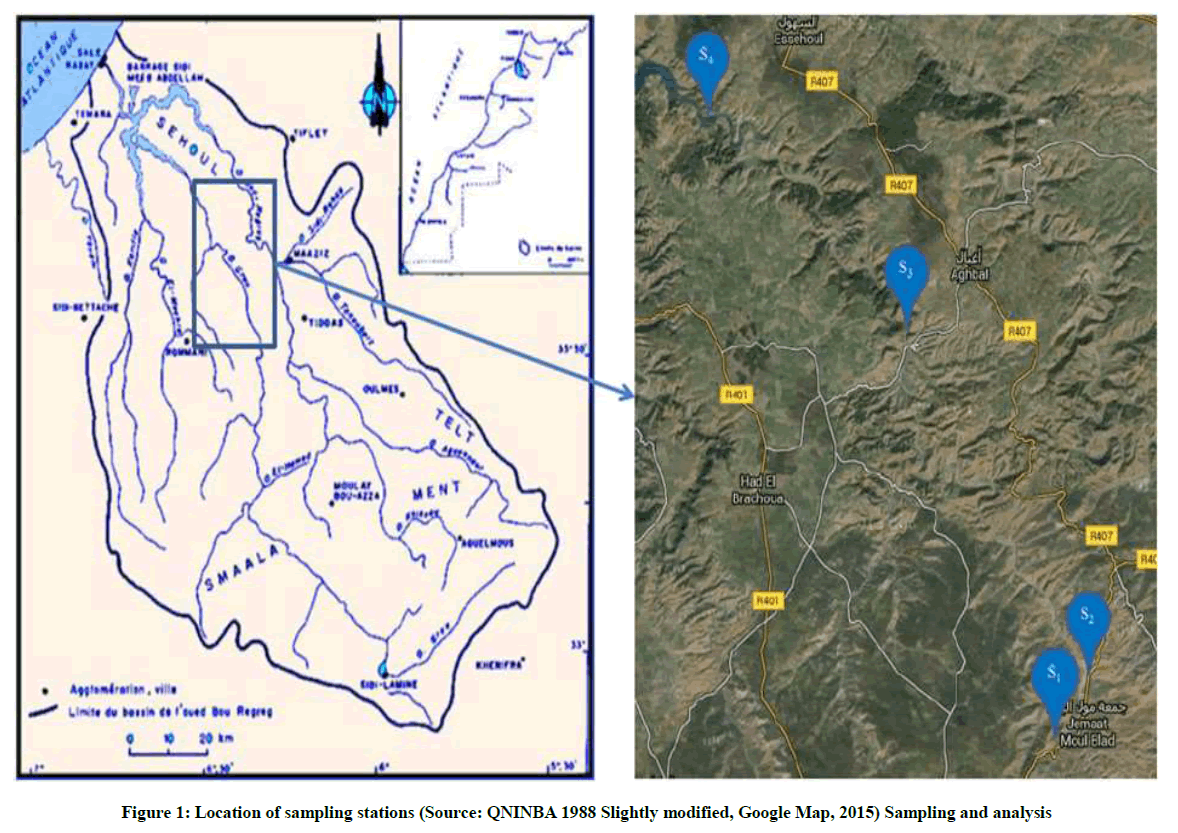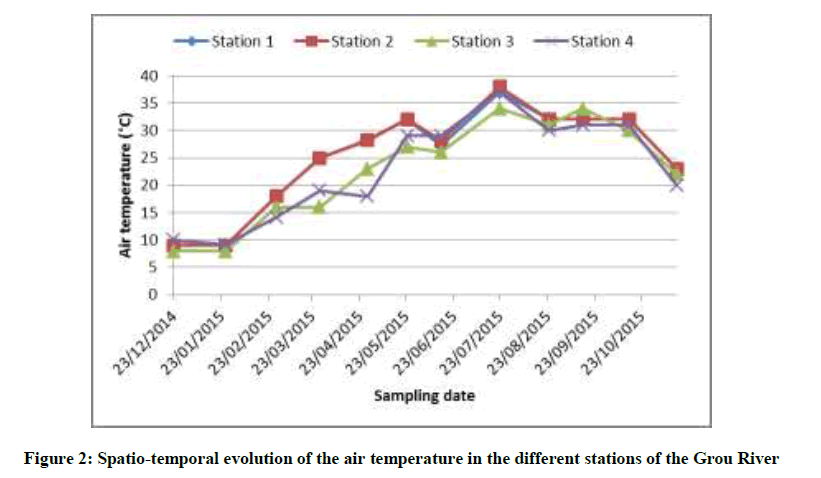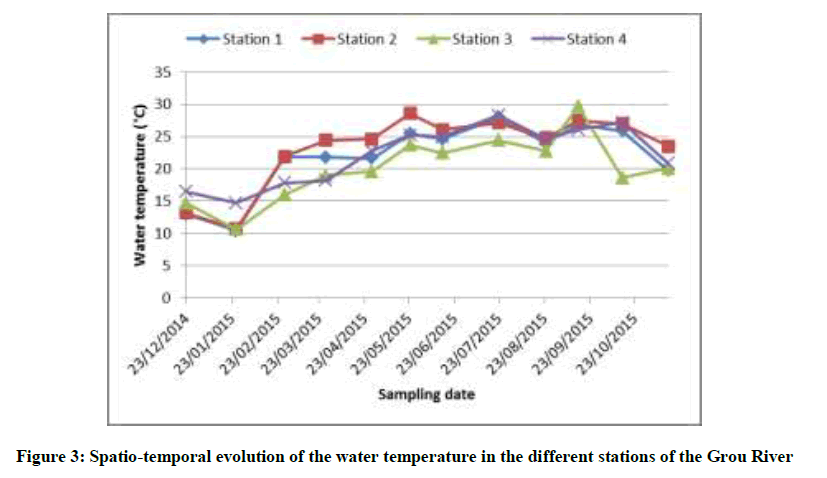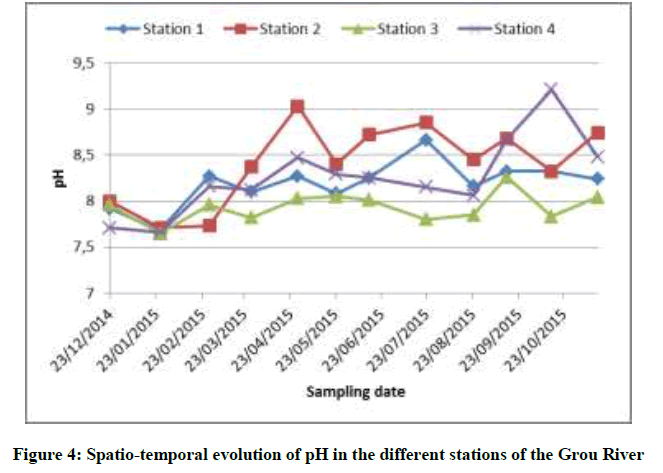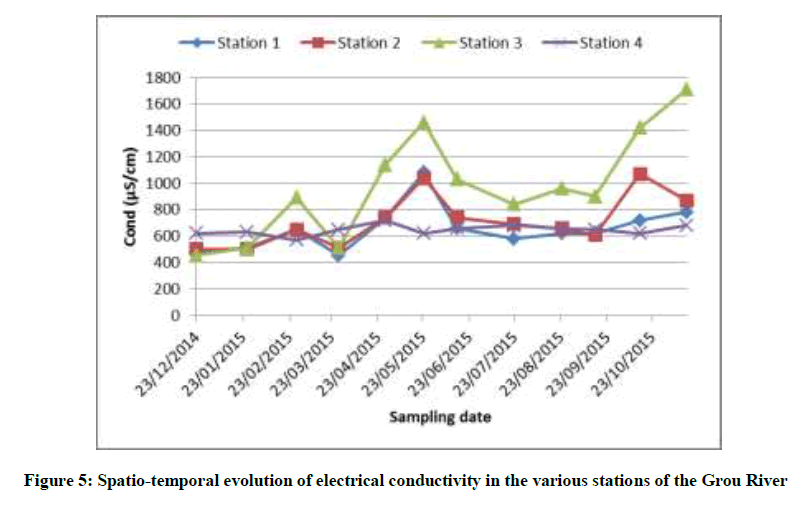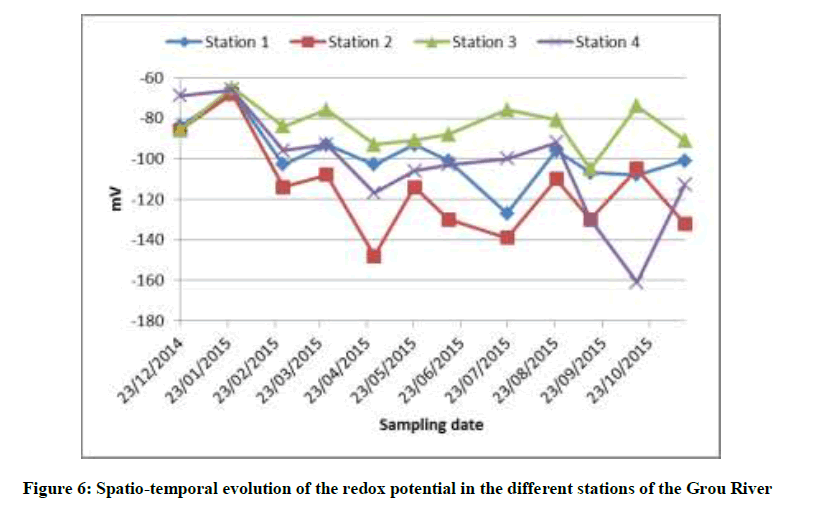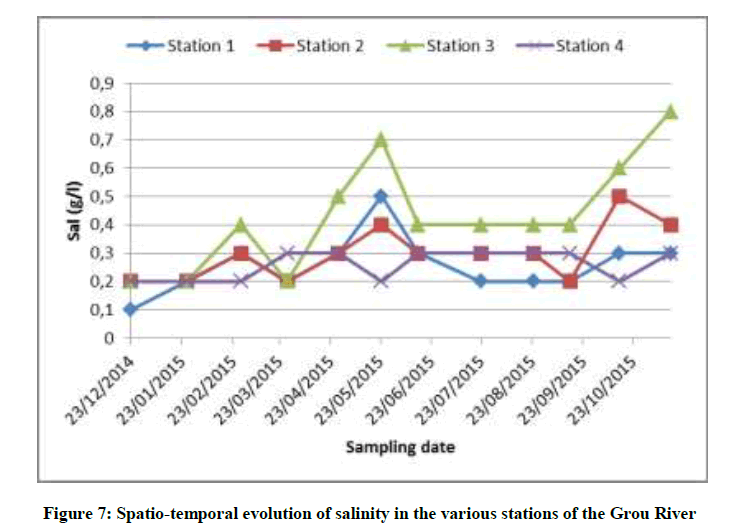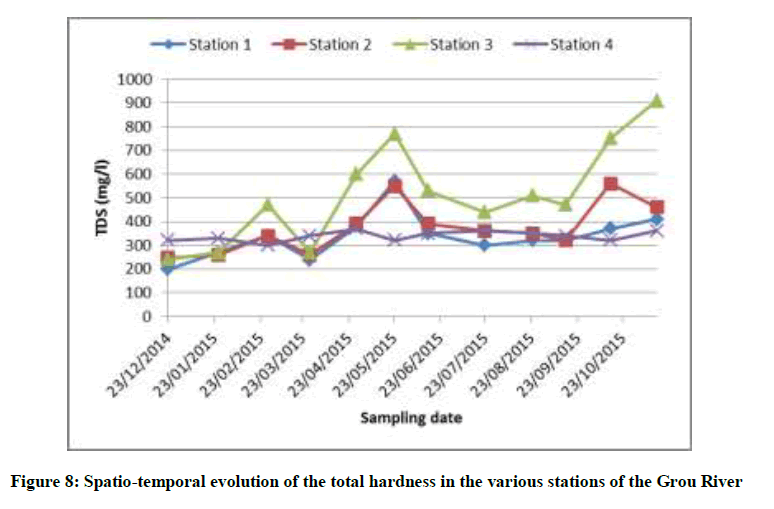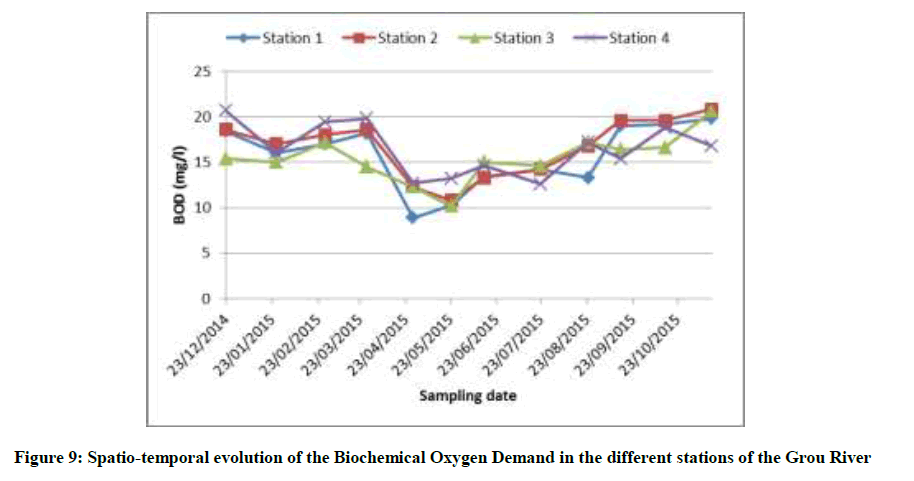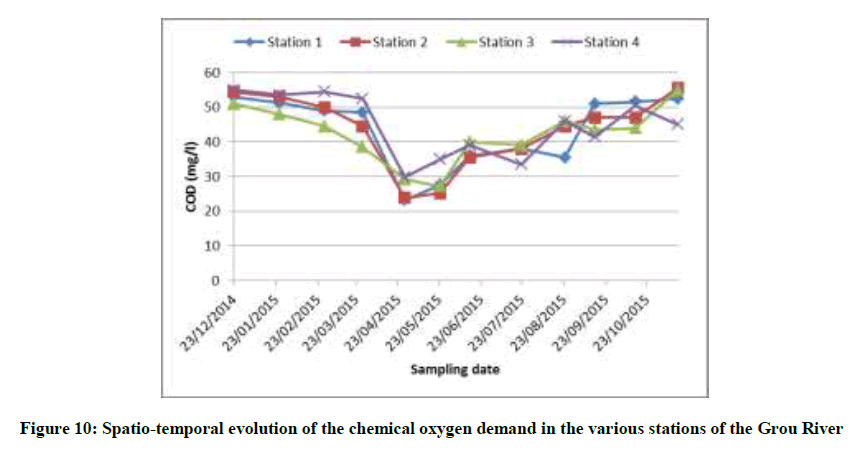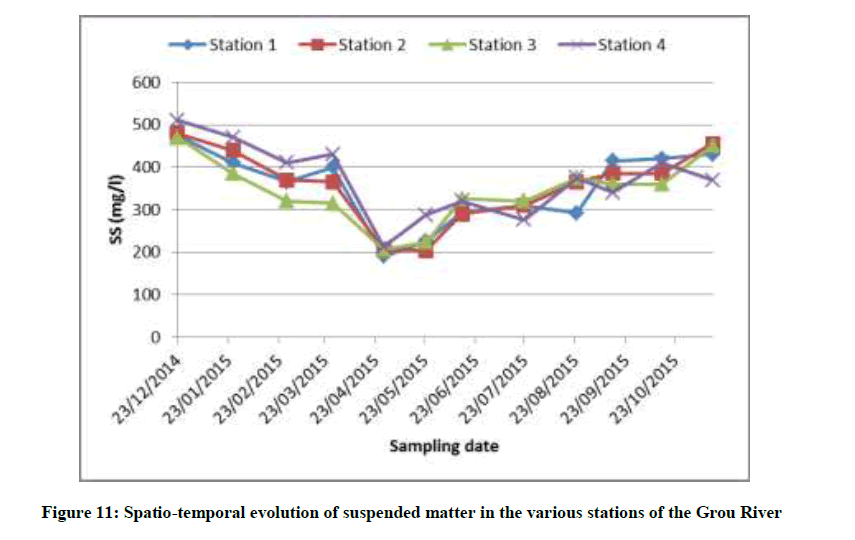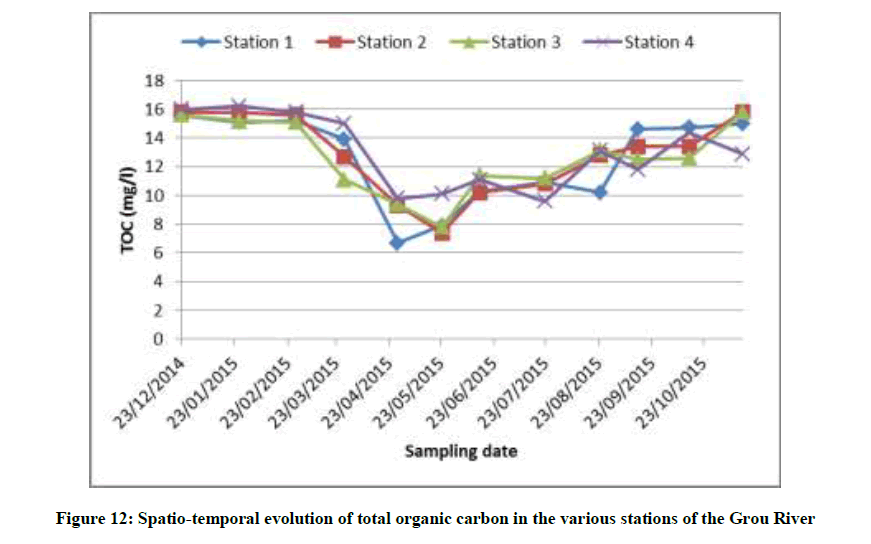Research Article - Der Pharma Chemica ( 2018) Volume 10, Issue 5
Spatio-Temporal Variation of the Physico-Chemical Quality of the Waters of the Grou River (Rabat Region, Morocco)
Karim Arifi1,2*, Latifa Tahri2, Abdallah EL Abid3, Fatima Zahra Hefiane2, Souad Elblidi2, Ahmed Yahyaoui1 and Mohammed Fekhaoui2
1Faculty of Science, University Mohammed V, Ibn Battuta Av, PB: 1040 Agdal, Rabat, Morocco
2Scientific Institute, University Mohammed V, Ibn Battuta Av, PB: 703 Agdal, Rabat, Morocco
3Hydrology and Toxicology Laboratory of the Environmental and Industrial Hygiene, National Institute of Hygiene, Ibn Battuta Av, Agdal, Rabat, Morocco
- *Corresponding Author:
- Karim Arifi
Faculty of Science
University Mohammed V
Ibn Battuta Av, PB: 1040 Agdal, Rabat, Morocco
Abstract
In Morocco, the Grou River is one of the main rivers that feed the reservoir of the Sidi Mohammed Ben Abdellah dam (SMBA) for the production of drinking water. However, this watercourse is particularly threatened by the problem of pollution, due to the presence of human activities all along its bed. It is in this context that the purpose of this study is to assess the physico-chemical quality of the waters of this watercourse. Four sampling stations that have been selected on the river bed from the entrance of the rural Jmaa Moulblad to the downstream in confluence with the SMBA reservoir. According to a monthly frequency (December 2014 - November 2015), we analyzed 11 physico-chemical parameters (T° of the area, temperature of the area, water temperature (T° of water), hydrogen potential (pH), Electrical conductivity (EC), Redox potential (mV), Salinity (Sal), Total hardness (TDS), Biological Oxygen Demand (BOD), Chemical Oxygen Demand (COD), Suspended Solids (SS) and Total Organic content (TOC). The results obtained describe a worrying situation of the state of this watercourse, especially at the station S2 which receives directly the wastewater coming from the rural commune of Jmaa Moulblad without any previous treatment. To remedy this problem, we recommend preliminary treatment of wastewater before being discharged and the implementation of a plan for the sustainable management and management of the River Grou watershed.
Keywords
Pollution, Physicochemical, Management, Jmaa moulblad, Morocco
Introduction
Water is an indispensable resource for life. It deserves particular attention, given the dangers to which it is subjected by human activities (urban discharges, industrial activities, agriculture, etc.) [1]. These activities tend to diminish the potential of good quality water resources [2]. But also have a negative impact on the health of the population, water use (water catchment, bathing, etc.) and subsequently compromises socio-economic development [3,4].
In Morocco, a country with a semi-arid climate, the water potential is relatively limited and unpredictable [5]. This potential is affected by the pollution problem in all regions, especially the Rabat region, due to its growing demography and the continued development of the industrial and agricultural sector. In the area between the rural commune of Jmaa Moulblad and the reservoir of the SMBA dam, the Waters of the River Grou are used for livestock watering, drinking water production, bathing and other activities of the population. However, this river is affected by the pollution problem, despite the very important role it plays in the region. Indeed, during its downstream flow it receives waste water from the rural community of Jamaa Moulblad, the inputs of small runoffs, especially in winter, from mountains and agricultural lands threatening its quality. It is within this framework that this study aims to evaluate the physico-chemical quality of the waters of this river to remedy this problem.
Materials and Methods
Study site and sampling stations
The Grou River is one of three watercourses that feed the Sidi Mohammed Ben Abdellah dam reservoir (SMBA) in Morocco, with 38% alongside the River Bou-Regreg (50%), River Korifla (12%). Its watershed, with an area of 3820 km2, is elliptical in shape and forms part of an essentially impermeable substratum (primary rocks of the Central Plateau), bounded on the north by the Bou-Regrer watershed, on the west by the watershed Korifla, to the east and south by the watershed of the River Oum-er-Rabia [6].
The Oued Grou is one of the three rivers that feed the dam of the Sidi Mohammed Ben Abdellah dam (SMBA) in Morocco, with 38% next to the Oued Bou-Regreg (50%) and the Oued Korifla (12%). Its 3820 km2, elliptic-shaped watershed is embedded in an essentially impervious substratum (primary rocks of the Central Plateau), bounded on the north by the Bou-Regrer watershed, on the west by the watershed Korifla, east and south by the watershed Oued Oum-er-Rabia [7,6].
In our study, the choice of stations was taken with great caution throughout the wad, taking into account a number of criteria such as accessibility, direction of flow, sources of pollution, distance In relation to the SMBA dam and so that these sampling points are the most representative, so a total of four stations were selected for the follow-up of the study (Figure 1).
Station S1: Located further upstream, this station has been chosen as a reference point.
Station S2: Located immediately downstream after the confluence zone with the waste water coming from the rural commune of Jmaa Moulblad without any previous treatment.
Station S3: Located at 35 km from S2 where the waters cross a distance more or less sufficient for the setting up of the phenomenon of self-purification.
Station S4: Located 30 km from S3 further downstream to the confluence zone with the waters of the SMBA dam rich in organic matter under the effect of eutrophication.
Sampling is done once a month (December 2014 - November 2015) at the level of each station chosen. For physicochemical analyzes, the water is taken from 1.5 liter plastic bottles, previously rinsed with water from each study station. At each sampling, the temperature of the area, water temperature, electrical conductivity (CE), hydrogen potential (pH), redox potential (mV), Salinity (Sal) and total hardness (TDS) were measured in situ in the field using portable waves. The other parameters are subsequently measured immediately upon our return to the laboratory. Transport is carried out in a cooler at a low temperature (+4°C). The analytical techniques followed are those described by AFNOR [8] and Rodier [9].
Results and Discussion
Air temperature (°C)
The air temperatures measured during the study year show markedly irregular spatio-temporal variations (Figure 2). The lowest average monthly temperatures are measured during the winter period, with a minimum of 8°C recorded at station S3 in December 2014 and January 2015, while the highest temperatures are measured during the summer period, with a maximum of 38°C recorded in July 2015 at station S2.
Water temperature (°C)
The water temperatures of the four study stations show very significant spatial and temporal variations (Figure 3), which are generally hot in summer (maximum 29.7°C) and cold in winter (minimum 10.4°C). By way of comparison, at station S4, the recorded values of temperatures are close to those measured by [10]; 31°C and 15°C at the confluence with the SMBA dam.
Referring to these results, we can say that the profile of seasonal variations in water temperatures follows that of atmospheric temperatures in relation to the climate of the region. Therefore, the temperature of the water remains linked to local conditions (climate, duration of sunshine, flow) [11]. It is an ecological factor that plays a very important role in the development and growth of organisms living in water. It acts on density, viscosity, solubility of gases, dissociation of dissolved salts, evaporation, self-purification, as well as on the rates of chemical and biochemical reactions [12]. According to the Moroccan surface water standard [13], the temperatures measured in the Grou River waters belong to the middle to excellent class.
Hydrogen potential (pH)
The waters of the downstream part of the Grou River recorded a seasonal variation in pH between 7.65 and 9.21 (Figure 4). This pH is relatively alkaline due to the effect of the rejections that it receives throughout its course. Low values are recorded during the winter period because of the acidity of precipitation, while the highest values are recorded during the summer period because of the bacterial activity which degrades the organic matter abundant at the bottom and because of the activity Photosynthesis of algae. In general, pH is the sum of the stability of the equilibrium established between the different forms of carbonic acid and is linked to the buffer system developed by carbonates and bicarbonates [14,15]. The effects of a pH above 8.5 are the taste similar to soda and the presence of deposits [16].
In conclusion, the spatio-temporal variations in the pH of the waters downstream of the Grou River are characterized by an alkaline pH, with the exception of the station S3 which has a pH slightly lower than 8.0 due to the effect of self-purification. It is above 8.0 at all stations in all months except months (December, January and February), exceeding the threshold value recommended by the World Health Organization (WHO) (which should be less than 8). According to [17] water that has a pH of more than 8.0 is difficult to treat.
Electrical conductivity (μS/cm)
The measurement of conductivity is a good assessment of the degree of mineralization of water where each ion acts according to its concentration and conductivity. The electrical conductivity reflects the degree of global mineralization, and provides information on the salinity rate [18].
The results obtained in the downstream part of the Grou River show significant spatial and temporal variations. They fluctuate between 454 μS/cm in March (S1) and 1710 μS/cm in October (S3), thus showing different spatio-temporal variations (Figure 5). These values remain below the Moroccan surface water standard (2700 μs/cm) [13]. This made it possible to classify the waters of the downstream part of the Grou River in the category of good to medium quality. This mineralization is much lower than that shown in some Moroccan Rivers such as Khuman River [19], Tizguit River [20] and Boufekrane River [21].
The redox potential (mV)
In our study, the values of the redox potential vary between a minimum of -161 mV in S4 and a maximum of -65 mV in S3, thus showing very significant spatio-temporal variations. The lowest levels were recorded during the summer period, while the highest levels were recorded during the winter period (Figure 6).
While going from station S1 to station S2, a reduction in redox values is observed. This could explain the fact that the watercourse receives directly the waste water generated by the rural commune of Jmaa Moulblad without any prior treatment, thus causing the reduction of the oxygen levels and subsequently the degradation of the quality of the water. This finding is agreed with [10]; the high redox coincides with the high oxygen content while the low redox is consistent with the lack of oxygen.
Then, at the station S3, located at 35 km from station S2, sufficient distance to the implementation of the phenomenon of natural self-purification of water. The redox values recorded are increased due to the effect of self-purification and the effect of the low depth which favors the oxygenation of the water.
Finally, at the station S4, confluence zone with the waters of the SMBA (mesotrophic) reservoir, redox values recorded decrease again. This could be explained by the speed of the current which becomes almost zero and by the depth which becomes more and more important. These factors favor precipitation of nutrients and mineral salts, as well as decreased oxygen levels and reduced redox. Indeed, water loaded with nutrients is always the site of a low redox potential while clean water is the site of a high potential [22]. Reduction in lakes may result in excess nutrients and lead to the conversion of nitrates and sulphates to ammonium and hydrogen sulphide by anaerobic bacteria that tend to develop which would lead to the odor of rotten eggs [10].
In conclusion, the values of the redox potential obtained clearly show the polluting effect at the stations S2 and S4 respectively by the waste water and the waters of the SMBA (mesotrophic) reservoir. And the purifying effect at the level of the station S3 by the phenomenon of selfpurification.
Salinity (Sal)
In this study, the salinity values of the water collected at the four stations of the downstream part of the Grou River ranged from 0.1 g/ in December (S1) to 0.8 g/l in November (S3), tthus showing different spatio-temporal variations (Figure 7). This could be explained by the effect of the waste water coming from the rural commune of Jmaa Moulblad without any previous treatment and by the effect of the low slope which makes the speed of the current almost zero by inhibiting the phenomenon of self-purification. On the other hand, by the effect of the strong evaporation in the absence of any precipitation, the salinity increases during the summer period and by the nature of the soles crossed and the origin of the waters. According to [23]; Salinity is mainly related to the origin of the water.
On the other hand, there is a high salinity in the waters of the Grou River with an increasing gradient while going downstream.
Total Dissolved Solids (TDS)
The total dissolved solids of the water varies at the level of the downstream part of the Grou River according to the same gradient as that of the salinity, thus show very important spatio-temporal fluctuations. The values range from 199 mg/l (S1) to 711 mg/l (S3) in November (Figure 8). In fact, the higher the total dissolved solids, the greater the advance from the upstream to the downstream. This, once again, reflects the effect of the soil crossed and the discharges, provoking the precipitation of Ca++ and Mg++ cations on the one hand, and on the other hand the effect of the low slope which inhibits the self-purification phenomenon. On the other hand, there is a high total dissolved solids (TDS) which reflects a state of pollution of the waters of the Grou River.
Biochemical Oxygen Demand (BOD)
In our study, BOD levels ranged from 8.90 mg/l (S1) in April to 20.8 mg/l (S2) in November, thus showing very significant spatial and temporal variations (Figure 9).
First, the BOD levels at station S1 range from 8.90 mg/l to 19.8 mg/l with an average of 15.63 mg/l which exceeds the guide value. This can be explained by the fact that as the river flows downstream it receives more and more water from anthropogenic activities laden with organic matter. Then, the values increase slightly at the station S2, due to the effect of the waste water coming from the rural commune of Jmaa Moulblad without any prior treatment. Then, while going towards station S3, observes small random variations, thus creating a decreasing gradient from upstream to downstream, indicating a beginning of self-purification of the river. Finally, at the S4 station, its values increase slightly further due to the effect of the water from the SMBA (mesotrophic) reservoir.
In conclusion, in all stations in the downstream part of the Grou River, average BOD values obtained in both the summer and winter periods remain above the guideline value of European and Moroccan standards (NMES) (From 6 to 10 mg/l). As a result, the waters of Grou River are classified as poor quality.
The Chemical Oxygen Demand (COD)
In this study the recorded COD levels ranged from 23.2 mg/l (S1) in April to 55.5 mg/l (S2) in November, thus showing very significant spatial and temporal variations (Figure 10). In winter, the values obtained at all stations are higher than those measured during the summer period. This could be explained by leaching and runoff, especially at the S4 station located further downstream. Moreover, during the summer period, the levels recorded at the stations S1 and S3 are slightly lower than those recorded respectively at the stations S2 and S4. This could be explained by the effect of wastewater discharges from the rural commune of Jmaa Moulblad at station S2 and by the effect of the waters of the SMBA (mesotrophic) reservoir at station S4.
In conclusion, the average COD values recorded at the four stations in the downstream part of the Grou River, slightly exceed the Moroccan standard set at 40 mg/l [13]. As a result, the waters of the Grou River can be classified from good to medium quality.
Suspended matter (SS)
In this study, suspended solids (SS) concentrations ranged between 190 mg/l (S1) in April and 510 mg/l (S4) in December, thus showing very significant spatial and temporal variations (Figure 11), the values obtained during the winter period are higher than those measured during the summer period. This observation is in agreement with other studies done on other rivers such as Moulouya River in Morocco, Mellah River in Algeria, and the river in Senegal. In winter, high grades are the result of a sudden hydrological manifestation (flood), whose suspended matter load is attributed to an intense erosion of the watershed. The inputs of the flood are of organic and mineral origin (debris of organisms, organic and inorganic chemical compounds, sand, silt and clay). In summer, suspended solids concentrations are lower in all stations except for stations S2 and S4, which show slightly higher levels due to the effect of wastewater discharge from the rural commune of Jmaa Moulblad and to the effect of the waters of the reservoir SMBA (mesotroph).
In conclusion, the suspended solids values recorded at the four stations far exceed the Moroccan standard for surface water quality [13] set at 50 mg/l. As a result, the waters of the downstream part of the Oued Grou are classified as poor quality water.
Total Organic Carbon (TOC)
In our study, total organic carbon contents ranged between 6.7 mg/l (S1) in April and 16.2 mg/l (S4) in January, showing significant spatialtemporal variations (Figure 12).
In winter, the values obtained in all the stations are higher than those measured during the summer period, this can be explained by runoff and leaching, especially at station S4 located further downstream. On the other hand, there is a high concentration of total organic carbon, indicating a state of pollution of the waters of the Grou River. This finding is in agreement with [24-27]; explained the high total organic carbon load of the Lower Loukkos estuary (8.33 and 19.96 mg/l, in the upstream-downstream direction) due to intense erosion of the catchment, following heavy rains and the contribution of erosion and pollution.
In conclusion, the mean total organic carbon values recorded at the four stations of the Grou River 12.5 mg/l in S1, 12.7 mg/l in S2, 12.6 mg/l in S3 and 13 mg/l in S4 are higher than those recorded at Bou Regreg River 7.8 mg/l; [28] and those recorded at Jackson Harbor Estuary 4.54 mg/l; [29]. This increase can also be attributed to the effect of the discharges that this watercourse receives throughout its course on the one hand, and on the other hand to the effect of the waste water of the rural commune of Jmaa Moulblad at the level of the station S2 and to the effect of the waters of the SMBA (mesotrophic) reservoir at the station S4.
Conclusion
In the light of the results obtained in this work, the water quality of the Grou River is degraded, especially at the S2 station located in the rural area of Jmaa Moulbad, which generates very large quantities of wastewater without any prior treatment. Further downstream at the station S3 located 35 km from S2, a self-purification system is installed to slightly improve the water quality, but without recovering their initial properties, due to the morpho-dynamic characteristics of the River (low Slope) make self-purification long and incomplete. Finally, at the level of station S4, the foaming formations indicate that the pollutants remain always present in the River over a distance of more than 65 km.
In conclusion, the results obtained vary widely according to physicochemical parameters, seasons and stations. The majority of analyzes revealed levels that exceed Moroccan standards. Causes result from the unaccountable behavior of the population living along the watercourse, the exploitation of sands, discharges and runoff inputs during periods of flooding due to increased leaching in coincidence with the agricultural season where soils are rich in nitrogen-based products.
In order to remedy these problems, we recommend that wastewater discharges be treated beforehand before entering this river and the implementation of a plan for the sustainable management and management of the Grou River watershed. And it must be borne in mind that any pollution of its surface waters, no matter how small, will have serious consequences and will therefore represent a real crime for the region.
References
- M.L. Mc Kinney, Biosci., 2002, 52, 883-890.
- R.M. Mulliss, D.M. Revitt, R.B.E. Shutes, Water Sci. Technol., 1997, 36, 195-199.
- G.A.JR. Burton, R.E. Pitt, Stormwater effects handbook, a toolbox for watershed managers, scientists, and engineers. CRC/ Lewis Publishers., 2001, 875.
- A. Chahlaoui, P. Cugny, S. Lek, A. Zaid, M. Ramdani, Bulletin de la Société d'Histoire Naturelle., 1997, 133, 71-76.
- J. El Addouli, A. Chahlaoui, A. Berrahou, A. Chafi, A. Ennabili, Larhyss J., 2011, 09, 21-33.
- B. Cherrad, Le bassin versant de l'Oued Grou (Plateau Central Marocain) Etude hydro-climatologique. Thèse de Doctorat: Géographie : Université de Metz, 1997, 269.
- A. Qninba, M.A. El Agbani, M. Dakki, A. Ben Houssa, Bull. Inst. Sci., 1988, 12, 149-156.
- AFNOR., Qualité de l'eau. Recueil des Normes Françaises Environnement. Tomes 1, 2, 3 et 4. 1997, 1372.
- J. Rodier, L'analyse de l'eau naturelle, eaux résiduaires, eau de mer, 8th (Edn.), Dunod, Paris, 1996, 1383.
- R. Delhi, F. Benzha, A. Hilali, M. Tahiri, A. Kaoukaya, L. Baidder, H. Rhinane, J.P. Hangouet, ScienceLib., 2012, 4, 2111-4706.
- A. Brahimi, A. Chafi, J. Mater. Environ. Sci.,2014, 5, 1671-1682.
- L. Tahri, Diagnose écologique de de l’estuaire de Bou-Regreg: impact des rejets sur les differentes composantes de l’écosystème et évaluation des risques sanitaires. Thèse de doctorat Fac. Sci. Kenitra., 2010, 174.
- N.M. Norme Marocaine de qualité des eaux. Bull. Off. n°5062., 2002.
- S. El Blidi, M. Fekhaoui, Bull. Inst. Sci., 2003, 25, 57-65.
- N. Boughou, I. Majdy, E. Cherkaoui, M. Khamar, A. Nounah, Der Pharma Chemica., 2016, 8, 19, 93-99.
- USEPA, United States Environmental Protection Agency. The Water Sourcebooks, 2007, 9-12.
- Anderson,. Arch. Hydrobiol., 1975, 76, 411-419.
- J. Rodier, Analyse de l’eau : eaux naturelles, eaux résiduaires, eau de mer, 7th (Édn.), Dunot, Paris., 1984.
- A. Ben Moussa, A. Chahlaoui, El.H. Rour, J. Biol Chem. Sc., 2012, 6, 7096-7111.
- M. Touabay, N. Aouad, J. Mathieu, Ann Limnol., 2002, 38, 65-80.
- H. Lamrani, A. Chahlaoui, J. El Addouli, A. Ennabili, Science Lib., 2011, 3, 111-112.
- G. Michard, Faculté des sciences de Paris, St. Maur (France), 1967.
- S. El Blidi, Rizières du Gharb: Qualité physico-chimique, composition faunistique et évaluation de la contamination métallique des différentes composantes de l’agrosystème. Thèse de doctorat Fac. Sci. Rabat, 2005, 194.
- M. Makhoukh, M. Sbaa, A. Berrahou, M. Clooster Van, Larhyss J., 2011, 09, 149-169.
- A. Maoui, M. Kherouf, F. Derradji, Afrique Science., 2011, 07, 3, 49-54.
- A.D. N’diaye, M.S. Khadijettou Mint, M. Ould sid’Ahmed, M. Ould Kankou, Larhyss J., 2013, 12, 71-83.
- M. El Morhit, M. Fekhaoui, A. Serghini, S. El Blidi, A. El Abidi, A. Yahyaoui, M. Hachimi, Bull. Inst. Sci., 2012, 34, 2, 151-162.
- F. Zidane, K. Cheggari, J-F. Blais, N. Khlil, P. Drogui, J. Bensaida, J. Mater. Environ. Sci., 2012, 3, 99-108.
- V. Hatje, Environ. Geol., 2003, 44, 231-239.

